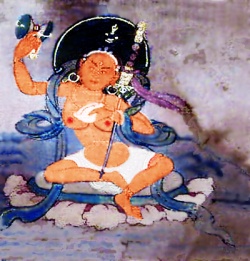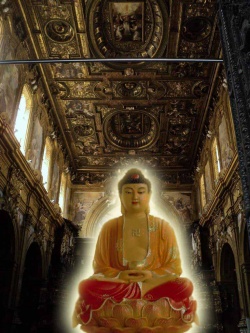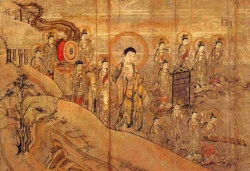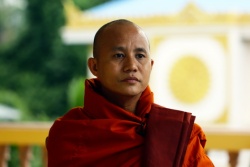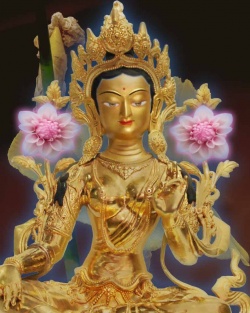Rise and Fall of Buddhism on Daya Basin
Orissa Review * December - 2007 20 River Daya which originates from the river Kuakhai at Balakati near Hirapur (famous for Chausathi Yogini temple) has a south western course of about 45 miles. It flows through Uttara, Dhauli, Kakudia, Aragarh, Beguniapara, Pandiakera, Balabhadrapur and finally discharges into Chilika lake.1 On its course, Daya is joined by the Bhargavi river, the Gangua Nalla, the Malaguni river, the Luna river and many smaller drainages from Khurda sub-division.2 Two important Buddhist vestige, whose traces are found today on the Daya basin is highlighted in this paper. Buddhism in Orissa flourished during the early Christian era independent of the Kusan patronage. In fact, till the coming of the Bhaumakar dynasty in the 8th century A.D., notable Buddhist rulers were not known to have thrived here more on popular support than on any court patronage. Magnificent monasteries adorned with superb images of Buddha and Bodhisattvas developed in course of time in various parts of this territory. Those areas became the centres of religious life of the people for many centuries.
It was in these monasteries that people thronged on many occasions to worship the images and uttered unnumbered prayers before them. These monasteries were the seats of culture and education in the country. Erudite scholars and teachers used to impart here both religious and secular instructions to people. These teachers were greatly loved and respected by the simple country folk for the blessed hopes they gave to their afflicted hearts. In course of time some of these monasteries grew up into famous university centres. As torch bearer of the Buddhist culture these centres attracted pupils and scholars from far and wide.3 The development of Mahayana Buddhism in Orissa may be studied through the historical growth of these monastic institutions and through the activities of the sages and philosophers of this religion. The Nagarjuni Konda inscription engraved during 14th year of the Mahariputa Virapurusadatta, testifies to the development of some Hinayanic strongholds at Tosali, Palura, Hirumu, Papila and Puspagiri by 3rd century A.D. Besides this, great Mahayanic institutions soon raised their heads at Bhora Saila, Tamralipti, Cheli- ta-lo, Viraja, Ratnagiri and many other places.4 Bhora Saila : A very famous Buddhist monastery that developed by the 4th and 5th century A.D. in Orissa was at Bhora Saila which was the abode of the famous dialectician Dignaga. Dignaga, the disciple of Vasubandhu was once invited to take the chair of chancellorship in the University of Rise and Fall of Buddhism on Daya Basin Dr. Saroj Kumar Panda Orissa Review * December - 2007 21 Nalanda.
During his short period of stay at Nalanda, he expounded several sutras and composed some logical and dialectical sastras. But very soon he had to come back to the sylvan retreat Orissa - the famous Bhorasaila - where he set himself to the task of edifying the Buddhist epistemology. It was here that Dignaga built the superstructure of Buddhist logic. On the foundation of Vijnanavada metaphysics, laid down by Asanga and Vasubandhu, Dignaga completed his great work Pramana Samuchaya. This work revolutionised the Indian thought in the contemporary period. It was also in this monastery that the Sankhya philosopher Iswarkrishna defied Dignaga and was decisively defeated by the later in a series of metaphysical combats. Acharya Dignaga is ever remembered in the cultural tradition of Orissa. The village Delang in Puri district is named after him as it was associated with his missionary activities.5 From Delang upto the vicinity of Bhubaneswar there is found a group of low hills, the notable among which are known as the Vindheswari, Saanla, Paanra, Bani Vakreswar, Jamuna Jhadapada, Aragarh and the Dhauli.
All these hills are honeycombed with caves. A large number of Buddhist monks resided in those hills upto the late medieval period.6 Bhorasaila can be identified with Bindheswari hill, presently better known as Biswanath hill.7 One can find the images of Kshetrapal, Astika, Jagatkaru, Haraparvati and a few other broken sculptures in the shrine of Devi Bindheswari on the hill top behind the main temple of Biswanath. There is a small rock cut cave, sufficient to hold a man, still existent on the north side of the hill. A large piece of rock is lying near it which indicates the pre existence of the main cave, whose roof has later collapsed. A large rock cut sculpture of Varaha Vishnu at the foot of the hill also commemorates this hill as the Bhora-Saila of Buddhist fame.8 Aragarh : Aragarh otherwise known as Airagarh is situated north of the river Daya in Haripur Gram Panchayat of Delang Block. The Aragarh hill is 256 feet high from ground level, and stretches over 3 K.Ms. from east to west.9 On its top (eastern side) there stands a two storied, flat roofed Buddhist Chaitya (temple). The backside of the Chaitya has been closed by a masorry wall, two sides fitted with grilled stoned windows measuring 21 X 20. The front remains wide open for entry into the inner chamber. Its four pillars are carved with nagakanyas and gajasimha motifs.
In the upper chamber, Buddhist icons were worshipped. The ground floor was for mendicants. They practised yoga and lived there. A Kunda (54 X 50 X 42) carved out of muguni rock is found 4 feet west of this Chaitya. A broken Buddhist icon of 42 X 21 is also found in this place. Another broken icon of 2 feet X 2 feet, made of igneous rock is lying south of this Chaitya. As many Buddhist icons are found here and there on the hill top of Aragarh, it confirms this place as a great stronghold of Buddhism.10 The site and images of Aragarh dates back to 10th or 11th century A.D.11 Buddhist monuments of Haripur : During the year 1954, four remarkable Buddhist icons of Vajrayana faith were recovered from the paddy field of Aragarh village. The villagers of Haripur removed them to their Bhagavataghara for worship. These images measuring 2 feet in height are excellently carved with characteristic features of the Somavansi period.12 Five stupas were also collected from the same place and preserved in the same village. The description of the figures are as follows : Orissa Review * December - 2007 22 First Figure : The first figure of the group is three headed and six armed. The three hands of right side display arrow, sword and thunder bolt. The hands on the left side represent bell, shield and a mudra. The lotus pedestal is flanked by gajasimha motifs.
A devotee in kneeling position is found below the lotus pedestal. The top most part of the slab contains a Dhyani Buddha and garland bearing apsaras. It can be identified with Manjusri and worshipped as Kamadeva of Hindu religion.13 Second Figure : The Second figure characterizes with three hands, six arms, a third eye on the forehead and a Dhyani Buddha Statue at the top. The three hands on the right side display thunder bolt, rosary and spouted vessel. One of the left hands is broken. The other two hands hold a lotus across the chest. The lotus pedestal is supported by gajasimha figure. Below the pedestal are seen a leap of offerings, kneeling devotees and a hero in full battle order. Two flying apsaras holding garlands in their hands are honoring on the arial region. This image is known as Avalokitasvara. It is also regarded as the God of heroic people.14 Third Figure : The third image carved seated crossedlegged on a multi pillar lotus pedestal has four hands, of which the right two display Vajra and fruit like object. The left hands placed over the left lap. On the other side of the lotus pedestal are found gajalaxmi figures. The prabhagamandala behind the head is flanked by flying apsaras holding wreathes in hands. The pedestal, like other figures contain kneeling devotees and heaps of offerings. This image in known as Baudhahara and worshipped as destroyer of ignorance and source of knowledge.15 Fourth Figure : The fourth and last figure of this group is carved seated in a lotus pedestal with a well decorated torana in the background. Of his two hands, right one is placed over the thigh and the left display Varada mudra. Among other decorations, one can notice flying apsaraswith garlands, jatamukta over the head, upavita on various parts of the body and devotees amidst heaps of offerings.
The lotus pedestal as usual is supported by gajasimha figure on either side. This statue is identified as Buddha and worshipped as God who is omnipresent.16 Among the five stupas recovered so far, four are circular made of hard stone. Each of these pillars consist of five folds, narrowing gradually from bottom to top. The seventh pillar has seven folds and that also narrowed down from bottom towards top.17 Hinayanism and Mahayanism prevailed side by side in Orissa, though the later had predominance over the former. During the 7th and 8th century A.D. tantric Buddhism emerged as a dominant force in Orissa.18 Tantrism also claims the status of the fifth Veda among the ancient religious literature of the Hindus. The philosophy of tantrism in both cases of Hinduism and Buddhism is almost the same as also their mystic practices to achieve the ultimate goal of absolute non-duality. Orissa was one of the main centres of Saiva, Sakta and Buddhism tantrism in the medieval period between the 7th and 11th century A.D.19 In the political front, with the ascendancy of the Bhaumakaras, the Mahayan Buddhism came into prominence in Orissa. In the middle of the 10th century A.D., the central authority passed away from the hands of the Bhaumakara dynasty to those of the Somavamsies. As the Somavamsi rulers were leaning towards Brahminism, Buddhism received a setback.
The rulers spread Orissa Review * December - 2007 23 Saivism in cost of Buddhism. The Gangas who came in quick succession also adhered to Brahminism. If any credence is to be given to traditions, then it has to be believed that Buddhism were prosecuted during their rule.20 The decline of Buddhist monasteries on Daya basin during Ganga period is known from the following description of Madalapanji : Madan Mahadev, the Ganga king of Orissa who ruled for 15 years during 12th century A.D. had established his capital at Sahajapari Grama (now under Delang P.S.). Once he along with his queen decided to arrange a Test between the Brahmins and the Bauddhas to prove superiority of any one religion. The test was conducted in the royal court. Without the knowledge of both the sect, a snake was kept inside an empty earthern pitcher. Then the pot was covered and placed before them. At first the Bauddhas were asked about the matter inside the earthern pitcher. They replied snake in it. Then the Brahmins were asked the same question. They replied ashes inside the pot. When the pitcher was opened, ashes were found within it. In fact, the Brahmins through tantra converted the snake into ashes. The Buddhists were defeated in this competition. The importance and dominance of Brahmins continued.21 On fatigue, many Bauddhas jumped into river Daya to end their lives.
Some others left the monasteries for ever in fear of behead by the king.22 By the way, the Buddhist stronghold over Bhorasaila and Aragarh declined. But the dying flame of the faith lingered in Orissa for several centuries more, that is, at least till the 16th Century A.D.23
References :
1. S.K. Panda, A Reflection on Some Historical Remains on Daya Basin, Orissa Review, Vol. LV, No.-7 (1999), P. 23. 2. S.L. Maddox, Final Report on Survey and Settlement of the Province of Orissa, Vol.- II, (Calcutta, 1900), P. 638. 3. N.K. Sahu, Buddhism in Orissa (Utkal University, 1958), PP. 80-81. 4. Ibid, P. 81. 5. Life and Activities of Dignaga, Journal of London Royal Asiatic Society, Vol.- I, (1905), P. 226. 6. Madalapanji, (ed). A.B. Mohanty, Second Edition, Cuttack, 2001, P. 18. 7. S.K. Panda, Baudha Khestraru Saiva Pitha, Darshaniya Biswonath Pahada, Utkal Prasanga, Vol.- 60, No.- 4 (2003), P. 9. 8. R.P. Mohapatra, Archeology in Orissa, sites and monuments, Vol.- I, (Delhi, 1986), P. 118. 9. D. Champati, Aragadara Itibruti (Oriya), (Jatni, 1989), P. 10. 10. Ibid, P. 18. 11. T.E. Donaldson, Religious Art of Orissa, N.R. Pattanaik (ed), Religious History of Orissa, (Delhi, 2004), P. 462. 12. R.P. Mohapatra, op. cit, P. 31. 13. S.K. Panda, A Reflection on Some Historical Remnants of Khurda Kingdom (unpublished), Berhampur University, 1994, P. 69. 14. Ibid, P. 70. 15. Ibid. 16. Ibid, P. 71. 17. Ibid. 18. N.R. Pattanaik, Religious History of Orissa, (Delhi, 2004), P. VI. 19. S.C. Dey, Tantrism in Orissa, N.R. Pattanaik (ed), op.cit., P. 33. 20. N.R. Pattanaik, op.cit., P. 33. 21. Madalapanji, op. cit., P. 18. 22. S.K. Panda, Utkal Prasanga, op. cit., P. 10. 23. N.N. Vasu, The modern Buddhism and its followers of Orissa, (Calcutta, 1911), P. 37. Dr. Saroj Kumar Panda is the Principal in the Gadibrahma College, Delang, Puri.
